|
|
|
 |

 |
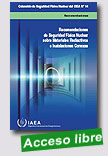 |
Recomendaciones de Seguridad Física Nuclear sobre Materiales Radiactivos e Instalaciones Conexas
OIEA, 2012, 47 p.
La finalidad de la presente publicación es proporcionar orientaciones a los Estados y a las autoridades competentes sobre la manera de elaborar o reforzar,
aplicar y mantener un régimen de seguridad física nuclear para los materiales radiactivos, las instalaciones conexas y las actividades conexas. A tal efecto es preciso establecer o mejorar su capacidad para aplicar un marco legislativo y dereglamentación relativo a la seguridad física de los materiales radiactivos, lasinstalaciones conexas y las actividades conexas a fin de reducir la probabilidad
de que se cometan actos dolosos relacionados con esos materiales.
|
Extraído de:
http://www-pub.iaea.org/books/IAEABooks/8811/Nuclear-Security-Recommendations-on-Radioactive-Material-and-Associated-Facilities-Spanish-Edition
|
 |
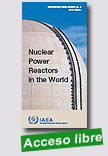 |
Nuclear Power Reactors in the World - 2012 Edition IAEA, 2012, 79 p.
This is the 32nd edition of Reference Data Series No. 2, which presents the most recent reactor data available to the IAEA. It contains summarized information as of the end of 2011 on power reactors that are in operation, under construction and shut down, and performance data on reactors operating in IAEA Member States, as reported to the IAEA. The information is collected through designated national correspondents in the Member States and the data area used to maintain the IAEA's Power Reactor Information System.
|
Extraído de:
http://www-pub.iaea.org/books/IAEABooks/8954/Nuclear-Power-Reactors-in-the-World-2012-Edition
|
 |
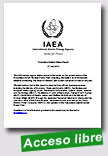 |
Fukushima Daiichi Status Report 27 July 2012
IAEA, 27 July 2012, 11 p.
The IAEA issues regular status reports to the public on the current status of the Fukushima Daiichi Nuclear Power Plant, including information on environmental radiation monitoring, the status of workers, and current conditions on-site at the plant. |
Extraído de:
http://www.iaea.org/newscenter/focus/fukushima/statusreport270712.pdf
|
 |
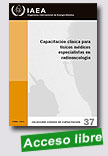 |
|
Extraído de:
http://www-pub.iaea.org/books/IAEABooks/8863/Clinical-Training-of-Medical-Physicists-Specializing-in-Radiation-Oncology
|
 |
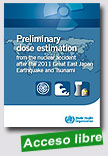 |
Preliminary Dose Estimation from the nuclear accident after the 2011 Great East Japan Earthquake and Tsunami
World Health Organization (WHO), May 23 2012, 120 p.
The earthquake and tsunami in Japan on 11 March 2011 led to releases of radioactive material into the environment from the Fukushima Daiichi nuclear site. This report describes a preliminary estimate of radiation doses to the public resulting from this accident. These doses are assessed for different age groups in locations around the world, using assumptions described in the report.
|
The dose assessment forms one part of the overall health risk assessment being carried out by WHO of the global impact of the accident at the Fukushima Daiichi nuclear power plant. The health risk assessment is the subject of a separate WHO report which will be published in Summer 2012.
Extraído de:
http://www.who.int/ionizing_radiation/pub_meet/fukushima_
dose_assessment/en/index.html |
 |
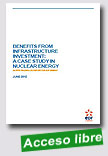 |
Benefits from Infrastructure Investment: A Case Study in Nuclear Energy
Institute for Public Policy Research for EDF Energy, June 2012, 44 p.
Government policy to promote a new generation of nuclear power plants could boost the UK economy by more than £5 billion a year, new research shows.
Figures from the Institute for Public Policy Research also suggest that rebuilding new nuclear energy capacity in the UK could create more than 32,000 additional jobs while giving a significant boost to annual exports.
|
In its National Policy Statements, the Government set out the “urgent need” for new nuclear electricity generation so the UK can meet its energy and climate change objectives.
It added that new nuclear power should be free to contribute “as much as possible” towards meeting the need for around 18 GW of new non-renewable capacity by 2025.The research by IPPR shows that if nuclear power met all the additional capacity required, the result would be a boost to UK GDP of up to 0.34 per cent a year and an annual economic gain of £5.1 billion. Furthermore, the investment could result in additional direct and indirect job gains of more than 22,000 a year, together with further induced jobs of up to 10,000 a year created by increased economic activity as a result of the associated investment.
The research was commissioned by EDF Energy, which has plans to build four new nuclear plants at Hinkley Point in Somerset and Sizewell in Suffolk, with a combined capacity of 6.4 GW, sufficient to power ten million homes.
Extraído de:
http://www.edfenergy.com/media-centre/press-news/Nuclear-revival-could-lead-to-5-billion-a-year-boost-to-UK-economy.shtml
|
 |
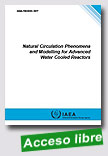
|
Natural Circulation Phenomena and Modelling for Advanced Water Cooled Reactors
IAEA Tecdoc, 2012, 438 p.
Based on an IAEA coordinated research project focused on the use of passive safety systems and natural circulation to help meet the safety and economic goals of advanced nuclear power plants, this publication includes the identification and definition of the thermo-hydraulic phenomena that affect the reliability of passive safety systems, characterization of each phenomenon, integral tests to examine the passive systems and natural circulation, and a methodology for examining passive system reliability. |
Extraído de:
http://www-pub.iaea.org/books/IAEABooks/8638/Natural-Circulation-Phenomena-and-Modelling-for-Advanced-Water-Cooled-Reactors
|
 |
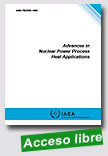 |
Advances in Nuclear Power Process Heat Applications
IAEA Tecdoc, 2012, 286 p.
Following an IAEA coordinated research project, this publication compiles the findings of research and development activities related to practical nuclear process heat applications. An overview of current progress on high temperature gas cooled reactors coupling schemes for different process heat applications, such as hydrogen production and desalination is included. The associated safety aspects are also highlighted. The summary report documents the results and conclusions of the project. |
Extraído de:
http://www-pub.iaea.org/books/IAEABooks/8692/Advances-in-Nuclear-Power-Process-Heat-Applications
|
 |
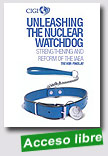 |
Unleashing the Nuclear Watchdog: Strengthening and Reform of the IAEA
Centre for International Governance Innovation, June 13, 2012, 156 p.
The events at the Fukushima nuclear power plant in March 2011 and the International Atomic Energy Agency’s (IAEA) part in the international response to the disaster, underscored the critical role the IAEA continues to play in ensuring global nuclear safety. The world’s hub of cooperation in the nuclear field, the IAEA is the nucleus around which all other parts of the global nuclear
|
governance system revolve, promoting safe, secure and peaceful nuclear technologies. In this 160-page report by CIGI Senior Fellow Trevor Findlay, all aspects of the Agency’s mandate and operations ― from its major programs on safeguards, safety, security and the peaceful uses of nuclear energy to governance, management and finance ― are examined. Unleashing the Nuclear Watchdog confirms that the IAEA requires strengthening and reform in certain areas, but does not need a dramatic overhaul. The report includes key strategic and programmatic recommendations.
The result of more than two years of research, this report is a joint undertaking by CIGI and the Canadian Centre for Treaty Compliance at the Norman Paterson School of International Affairs at Carleton University in Ottawa.
The report’s key findings and policy recommendations for strengthening and reforming the IAEA include: Since its establishment in 1957, the IAEA has evolved deftly, shedding unrealizable goals and adding new roles when requested, while coping with and learning from catastrophes and alarming non-compliance cases — Chernobyl, Iraq, North Korea, Iran — and adapting to tectonic international changes such as the end of the Cold War and the 9/11 attacks; The Agency fulfills irreplaceable functions in the areas of nuclear safeguards, nuclear safety and the promotion of the peaceful uses of nuclear energy, and is steadily developing a role in nuclear security; In recent years, the Agency has suffered increasing politicization of its governing bodies, become embroiled in a protracted compliance dispute with Iran and faltered in its response to the Fukushima disaster; The IAEA also faces significant external challenges: avoiding non-compliance surprises by exploiting new technologies to detect undeclared nuclear activities; preparing for the uncertain trajectory of nuclear energy post-Fukushima; gearing up for equally uncertain roles in verifying nuclear disarmament; meeting stakeholders’ expectations of improved transparency and accountability; and making ends meet in a period of international financial stringency; Above all, the Agency needs the renewed support of all its stakeholders, but especially its member states, in depoliticizing the Agency’s governing bodies; complying fully with their obligations; providing the organization with the necessary legal and other authorities; and contributing, in cash and kind, to all of the Agency’s activities.
Extraído de:
http://www.cigionline.org/publications/2012/6/unleashing-nuclear-watchdog-strengthening-and-reform-of-iaea
|
 |
|
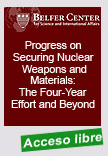
|
Progress on Securing Nuclear Weapons and Materials: The Four-Year Effort and Beyond
By Matthew Bunn, Associate Professor of Public Policy; Co-Principal Investigator, Project on Managing the Atom; Co-Principal Investigator, Energy Research, Development, Demonstration, and Deployment (ERD3) Policy Project, Eben Harrell, Research Associate, Project on Managing the Atom and Martin B. Malin, Executive Director, Project on Managing the Atom; March 2012
On the eve of the Nuclear Security Summit in Seoul, South Korea, a new study finds that an international initiative to secure all vulnerable nuclear stockpiles within four years has reduced the dangers they pose. |
|
|
|
|
|
|
|
